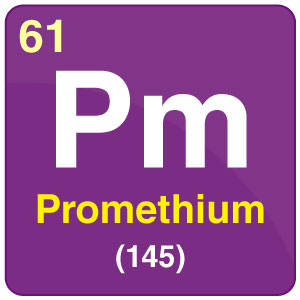Promethium

| Symbol | Pm |
| Atomic Number | 61 |
| Atomic Mass | (145) g.mol-1 |
| Discovered by | Mariinsky in 1945 |

Chemical Properties of Promethium
| Group | Lanthanides | Melting point | 1042°C, 1908°F, 1315 K |
| Period | 6 | Boiling point | 3000°C, 5432°F, 3273 K |
| Block | f | Density (g cm−3) | 7.26 |
| Atomic number | 61 | Relative atomic mass | [145] |
| State at 20°C | Solid | Key isotopes | 145Pm, 147Pm |
| Electron configuration | [Xe] 4f56s2 | CAS number | 7440-12-2 |
| ChemSpider ID | 22386 | ChemSpider is a free chemical structure database. | |
What is Promethium?
- Promethium is a chemical element with the symbol Pm and atomic number 61 in the periodic table.
- All of its isotopes are radioactive; it is one of only two such elements that are followed in the periodic table by elements with stable forms, a distinction shared with technetium.
Uses of Promethium
- Most of the element is used only for research purposes, except for promethium-147, which can be found outside laboratories. This isotope does not emit gamma rays, and its radiation has a relatively small penetration depth into matter and a relatively long half-life.
- Promethium is used in pacemakers. Some signal lights use a luminous paint containing phosphor that absorbs the beta radiation emitted by promethium-147 and emits light.
Properties of Promethium
- Chemically, promethium is a lanthanide, which forms salts when combined with other elements. It shows only one stable oxidation state of +3.
- Since traces of the element in nature is exceedingly scarce, the element is typically synthesized by bombarding enriched uranium with thermal neutrons to produce promethium-147.
- Promethium salts have a pink or red color that colors the surrounding air with a pale blue-green light.
Certain Facts About Promethium
- There is a strange star HR 465 in the Andromeda galaxy that contains a lot of Promethium. It is very radioactive and rare, so it is little studied: its chemical and physical properties are not well defined.

Comments